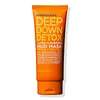What's inside
What's inside
 Key Ingredients
Key Ingredients

 Benefits
Benefits

 Concerns
Concerns

 Ingredients Side-by-side
Ingredients Side-by-side

Water
Skin ConditioningKaolin
AbrasiveBentonite
AbsorbentStearic Acid
CleansingCetyl Alcohol
EmollientGlyceryl Stearate Se
EmulsifyingCaprylic/Capric Triglyceride
MaskingCetearyl Alcohol
EmollientPEG-40 Stearate
EmulsifyingCeteareth-20
CleansingAloe Barbadensis Leaf Juice
Skin ConditioningTocopherol
AntioxidantCucumis Sativus Fruit Extract
EmollientXanthan Gum
EmulsifyingCitrus Aurantium Bergamia Fruit Oil
MaskingCitrus Aurantium Dulcis Oil
MaskingPhenoxyethanol
PreservativeParfum
MaskingMethylparaben
PreservativePropylparaben
PreservativeSodium Chloride
MaskingIron Oxides
Water, Kaolin, Bentonite, Stearic Acid, Cetyl Alcohol, Glyceryl Stearate Se, Caprylic/Capric Triglyceride, Cetearyl Alcohol, PEG-40 Stearate, Ceteareth-20, Aloe Barbadensis Leaf Juice, Tocopherol, Cucumis Sativus Fruit Extract, Xanthan Gum, Citrus Aurantium Bergamia Fruit Oil, Citrus Aurantium Dulcis Oil, Phenoxyethanol, Parfum, Methylparaben, Propylparaben, Sodium Chloride, Iron Oxides
Water
Skin ConditioningKaolin
AbrasiveGlycerin
HumectantPetrolatum
EmollientCetearyl Alcohol
EmollientPropanediol
SolventStearyl Alcohol
EmollientBentonite
AbsorbentPEG-100 Stearate
Glyceryl Stearate
EmollientButyrospermum Parkii Butter
Skin ConditioningMagnesium Aluminum Silicate
AbsorbentPyrus Malus Fruit Extract
Skin ConditioningPersea Gratissima Oil
Skin ConditioningXanthan Gum
EmulsifyingSorbitan Stearate
EmulsifyingPhenoxyethanol
PreservativeCaprylyl Glycol
EmollientCucumis Sativus Seed Oil
EmollientHexylene Glycol
EmulsifyingEthylhexylglycerin
Skin ConditioningCitric Acid
BufferingGlyceryl Acrylate/Acrylic Acid Copolymer
HumectantWater, Kaolin, Glycerin, Petrolatum, Cetearyl Alcohol, Propanediol, Stearyl Alcohol, Bentonite, PEG-100 Stearate, Glyceryl Stearate, Butyrospermum Parkii Butter, Magnesium Aluminum Silicate, Pyrus Malus Fruit Extract, Persea Gratissima Oil, Xanthan Gum, Sorbitan Stearate, Phenoxyethanol, Caprylyl Glycol, Cucumis Sativus Seed Oil, Hexylene Glycol, Ethylhexylglycerin, Citric Acid, Glyceryl Acrylate/Acrylic Acid Copolymer
 Reviews
Reviews

Ingredients Explained
These ingredients are found in both products.
Ingredients higher up in an ingredient list are typically present in a larger amount.
Bentonite is an aluminium phyllosilicate clay with great absorbent properties. The name 'bentonite' comes from the area where the largest source is found: Fort Benton, Wyoming.
As a clay, bentonite is often used to absorb excess oil and provide exfoliation. It has also been shown to have some antibacterial and anti-inflammatory properties. Studies show bentonite was effective at calming dermatitis from poison ivy and in diaper dermatitis of infants. Bentonite has also been shown to act as a barrier against toxic compounds on your skin.
Sunscreens containing bentonite display higher water resistance and stay on the skin for much longer. The sunscreens containing bentonite also show higher potency and UV light absorbtion.
Bentonite is naturally created from volcanic ash and several natural weathering/hydrothermal processes.
A common usage of bentonite is removing excess protein from white wines. Bentonite contains a property of being able to absorb large amounts of protein from aqueous solutions.
Phyllosilicate clay has a structure formed by sheets.
Learn more about BentoniteCetearyl alcohol is a mixture of two fatty alcohols: cetyl alcohol and stearyl alcohol. It is mainly used as an emulsifier. Emulsifiers help prevent the separation of oils and products. Due to its composition, it can also be used to thicken a product or help create foam.
Cetearyl alcohol is an emollient. Emollients help soothe and hydrate the skin by trapping moisture.
Studies show Cetearyl alcohol is non-toxic and non-irritating. The FDA allows products labeled "alcohol-free" to have fatty alcohols.
This ingredient is usually derived from plant oils such as palm, vegetable, or coconut oils. There is debate on whether this ingredient will cause acne.
Due to the fatty acid base, this ingredient may not be Malassezia folliculitis safe.
Learn more about Cetearyl AlcoholKaolin is a clay. It is used for oil control and to help minimize pores. Like other clays, kaolin has the ability to absorb excess sebum or oil. This can help clean out pores and mattify the skin.
Some types of kaolin may have exfoliating properties. When water is added to kaolin, it becomes a paste with small abrasive particles.
Most kaolin is a white color, but may be pink/orange/red depending on where it comes from.
The name 'kaolin' comes from a Chinese village named 'Gaoling'. Kaolin clay comes from rocks rich in kaolinite. Kaolinite, the mineral, has a silicate layered structure. Kaolinite is formed from chemical weathering of aluminum siilicate minerals.
Besides skincare, kaolin is commonly used to make glossy paper, in ceramics, toothpaste, and as medicine to soothe stomach issues.
Learn more about KaolinPhenoxyethanol is a preservative that has germicide, antimicrobial, and aromatic properties. Studies show that phenoxyethanol can prevent microbial growth. By itself, it has a scent that is similar to that of a rose.
It's often used in formulations along with Caprylyl Glycol to preserve the shelf life of products.
Water. It's the most common cosmetic ingredient of all. You'll usually see it at the top of ingredient lists, meaning that it makes up the largest part of the product.
So why is it so popular? Water most often acts as a solvent - this means that it helps dissolve other ingredients into the formulation.
You'll also recognize water as that liquid we all need to stay alive. If you see this, drink a glass of water. Stay hydrated!
Learn more about WaterXanthan gum is used as a stabilizer and thickener within cosmetic products. It helps give products a sticky, thick feeling - preventing them from being too runny.
On the technical side of things, xanthan gum is a polysaccharide - a combination consisting of multiple sugar molecules bonded together.
Xanthan gum is a pretty common and great ingredient. It is a natural, non-toxic, non-irritating ingredient that is also commonly used in food products.
Learn more about Xanthan Gum